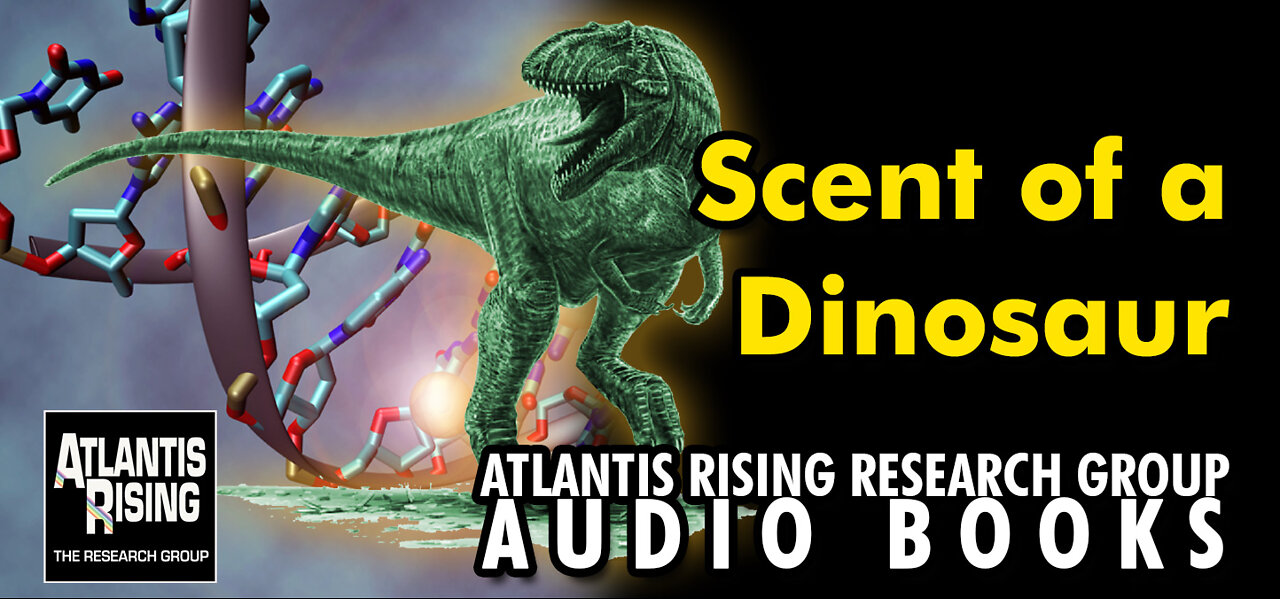Premium Only Content

Scent of a Dinosaur - Atlantis Rising Magazine
Visit Atlantis Rising Research Group at https://www.atlantisrising.com/
Something strange has been happening in Dino-World. Something disconcerting. It started in 2,000 on the dusty plains near Hell Creek, Montana, in a layer of earth deemed to be 65 million years old, when a large female T. rex skeleton was discovered. Ms. T. rex—or perhaps Mrs. T. rex, as she turned out to be pregnant—appeared to be another gift for the standard story of dinosaur history. But the gift unexpectedly turned out to be in a box from Pandora herself. As I described earlier (“The Strange Chaos of the Dating System,” AR #70), because the intact, 3.5-foot-long femur was so large and heavy (3000 lbs.), it had to be broken in half to be lifted out by helicopter. Some fragments of the freshly broken bone were sent to Dr. Mary Schweitzer at North Carolina State.
Mary Schweitzer was fully prepared for the opportunity. Earlier, while at Northern Montana University, she had discovered hemoglobin molecules in dinosaur bone samples, publishing a paper in 1997 on the subject. Once, curious that she had noted the distinct smell of death on a T. rex, similar to a cadaver in her lab, and given the conventional wisdom that such fossils were made up entirely of minerals, Schweitzer mentioned this anxiously to her mentor, the great dino-fossil hunter, Dr. Jack Horner. Apparently inured to the smell of death, he answered: “Oh, yeah, all Hell Creek bones smell.”
She was lucky to be at North Carolina State; the 1997 paper had not helped her career. Hemoglobin does not last 65 million years. In fact, the scientific consensus is that the longevity of protein is at maximum 100,000 years. But in 2004, in looking deeply into the T. rex sample from Horner, Mary Schweitzer now discovered soft-tissue, specifically, collagen, the kind of tissue that doesn’t last a week when placed on a shelf. More analysis found the fine structure of blood vessels, then osteocytes—the tiny cells of the bone. Another T. rex that strode the earth 68 million years ago revealed a fine network of almost-clear branching vessels, and within, as her 2005 paper in Science observed, “round microstructures,” namely and less diplomatically, blood cells. So it is not just dinosaur soft tissue but the presence of detectable proteins such as collagen, hemoglobin, osteocalcin, actin, and tubulin that must be accounted for. These are complex molecules that continually tend to break down to simpler ones. Schweitzer has even recovered fragments of the even more fragile and complex molecule, DNA (max longevity 25,000 years).
These were not the only dinosaurs revealing soft tissue. Schweitzer found this in several, including a 199.6 million-year-old specimen. But the problem is beyond Schweitzer’s pesky peering, for the list of dinosaurs discovered with soft tissue, even with remnants of skin, is long and growing. Other examples of soft tissue in fossils that are supposedly millions of years old have been found: muscle tissue in a salamander fossil that is supposed to be 18 million years old; retinal tissue in a mosasaur fossil that is supposed to be 70 million years old; and what appear to be bone cells from the same mosasaur fossil. A list can be found on http://www.theologyonline.com/forums/.... A fire was burning in Dino-World and there was plenty of material to fuel it. A 2010 National Geographic’s article titled, “Many Dino Fossils Could Have Soft Tissue Inside” reveals that the scientific community is expecting many more examples of dinosaur soft tissue in the future. These facts have been a thorn in their side for several years now as they are incredibly difficult to explain within an evolutionary (millions of years) time frame.
Thomas G. Kaye made an attempt in a 2008 paper, which was briefly hailed as the much needed fire extinguisher. His argument “Dinosaurian Soft Tissues Interpreted as Bacterial Biofilms” in the journal Plos One, was that these findings were merely “bio-film,” that is, a coating from extraneous biological organisms that had made it into the dead dinosaurs. This served briefly as the ‘go-to’ answer and dowsed the fire for about as long as it took Schweitzer to publish another paper. This one (Science, 2009), examining an 80 million-year-old Hadrosaur, demonstrated the reality of the detailed structures via mass spectrometry and molecular analysis. The bio-film theory decayed more quickly than its fossil subjects.
-
 0:19
0:19
Atlantis Rising Research Group
2 years agoJoin the ATLANTIS RISING RESEARCH GROUP!
1.26K2 -
 9:53
9:53
MattMorseTV
19 hours ago $19.38 earnedCNN just made a FATAL MISTAKE.
55.3K67 -
 25:23
25:23
Uncommon Sense In Current Times
16 hours ago $2.34 earnedInside Iran: Lana Silk on the Underground Church, the Islamic Regime & the Fight for Freedom
12.6K3 -
 12:59
12:59
Actual Justice Warrior
16 hours agoDemocrat Calls For Gangs To ATTACK ICE
6.85K16 -
 34:18
34:18
Athlete & Artist Show
4 days ago $1.57 earnedPanthers Win BACK 2 BACK, Bennett Wins Conn Smythe, Can Florida Keep The Rat Pack?
12K1 -
 23:08
23:08
DeVory Darkins
1 day ago $5.90 earnedCNN suffers HUMILIATING SETBACK after Iran confirms damage to nuclear sites
15.5K81 -
 8:09
8:09
Nate The Lawyer
1 day ago $1.70 earnedKarmelo Anthony Indicted for First‑Degree Murder Facing Life In Prison
13.3K9 -
 1:06:58
1:06:58
The Chris Cuomo Project
1 day agoAOC Is KILLING the Democratic Party Over Iran
11.3K10 -
 1:17:05
1:17:05
"What Is Money?" Show
1 day agoGary's Economics Explains Money (Badly)
16.5K6 -
 4:08
4:08
Sugar Spun Run
23 hours ago $2.13 earnedChicken Salad
16.9K7